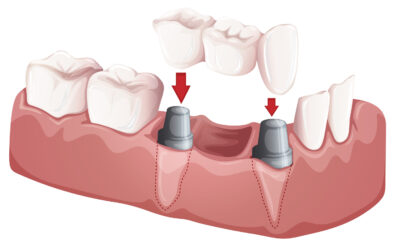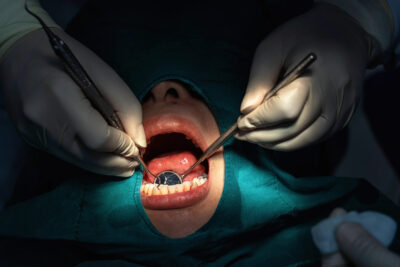
Patients with missing teeth or severely damaged teeth are often pleasantly surprised to learn that there are a wide range of options when it comes to lifetime solutions. In fact, one of the most successful treatments is a dental bridge procedure.
A dental bridge procedure can be effective for one missing tooth or multiple missing teeth. Since the permanent bridge looks just like your natural teeth, it can provide a wealth of aesthetic and oral health benefits.
When it comes to replacing missing teeth, your oral surgeon will explain all the options at your disposal at your initial consultation, from partial dentures to artificial teeth to a permanent dental bridge. In the meantime, it is helpful to understand the details of a dental bridge procedure. In addition, we will discover the different types of dental bridges and dental bridge cost, and how a dental bridge procedure can be a practical and comfortable way to replace missing teeth.
Table of Contents
Types of Dental Bridges
How Does Your Dentist Determine Which Types of Dental Bridges are Best for You?
Getting a Dental Bridge
FAQs for Dental Bridges
What Are the Benefits of a Dental Bridge?
Learn More About Dental Bridge Procedures in San Jose and Beyond
What is a Dental Bridge?
A dental bridge procedure is designed to replace missing teeth, or even a lone missing tooth, for the long term.
As the name suggests, a permanent dental bridge “bridges the gap” in your smile where missing teeth are present, and dental bridges are custom made to fit perfectly and match your existing teeth. In short, a dental bridge looks just like your natural teeth. It improves your appearance and oral health without affecting or impacting your remaining teeth.

There Are Generally Two Components of a Dental Bridge
Abutments
Abutments are the tiny connector posts that attach to the dental bridge and the dental implants. The abutments support the dental crowns that are an instrumental part of the dental bridge procedure.
Pontics
Once the abutments are placed, pontics come into play. Pontics are the replacement teeth or artificial teeth that fill in the gaps between the abutment teeth. So essentially, abutments support the replacement teeth and the dental bridge, while the pontics fill in the gaps for the missing teeth.
Types of Dental Bridges
A dental bridge procedure is not a one-size-fits-all solution, and dentists use different types of dental bridges designed to treat each patient’s unique oral health needs.
A sample of these different dental bridge procedures that may be recommended by your dentist and/or oral surgeon are as follows.
Traditional dental bridges
Traditional bridges are the most common type of dental bridge. A traditional bridge is comprised of dental crowns or caps with a series of artificial teeth in between. In a traditional dental bridge procedure, a dentist bonds these crowns to your natural teeth on either side of your missing teeth, and artificial or false teeth fill in the empty space.
A traditional bridge is recommended when your neighboring teeth (or abutment teeth) are healthy teeth on both sides of the gap of the missing tooth or teeth.
Cantilever dental bridge
A cantilever bridge is like a traditional bridge, as a traditional cantilever bridge uses dental crowns and artificial teeth to replace missing teeth. However, cantilever bridges have a crown on just one end, instead of both. Cantilever bridges are recommended when you only have natural teeth on one side of the dental bridge (or one side of abutment teeth). As a result, cantilever bridges are not always as strong as traditional bridges.
Maryland bridges or resin bonded bridges
A Maryland bridge (also known as a resin-bonded bridge) uses metal wings instead of dental crowns to secure the dental bridge in place. In a Maryland bridge, a dentist bonds the wings to the backs of the neighboring teeth to hold the dental bridge in place.
A Maryland bridge is generally used to replace missing front teeth because while it’s a great dental bridge solution, a Maryland bridge is not always strong enough to support the chewing forces used by the back teeth.
Implant supported bridges
Implant supported bridges are like traditional dental bridges and other types of permanent bridges. However, implant supported bridges rest on top of dental implants instead of natural teeth.
Dental implants are small, treated posts that are designed to replace missing tooth roots.
In addition, dental implants are recommended when other issues present, such as gum disease, bone loss, or other oral health problems that can arise from tooth loss over time.
In a dental implant supported bridge procedure, the dental implants must be fully integrated or fused with your jawbone for the dental implant supported bridge to be effectively connected to the dental implants. A dental implant supported bridge procedure takes roughly 3-6 months from start to finish, as there are two parts – placing the dental implants, and then adding the dental implant supported bridge.
Temporary bridges
A temporary bridge is less durable than a permanent bridge. However, it is designed to be a short-term solution and is generally used while your permanent bridge is being created and fabricated. Made out of acrylic or composite materials (as opposed to metal or porcelain framework), a temporary bridge placement protects your remaining teeth and gums. It keeps your other abutment teeth on the side of the gap from repositioning into the empty space.
How Does Your Dentist Determine the Types of Dental Bridges that Are Best for You?
Only a dentist can recommend the best types of dental bridges and bridge procedures for your unique oral health needs. Furthermore, this decision is generally based on the following:
- Your age, as dental bridges, are generally not a recommended solution for children.
- How many teeth need to be replaced (i.e., whether it is one tooth or multiple teeth)
- The size of the gap resulting from your missing teeth
- The condition of your abutment teeth, or the teeth on the side of the gap. (I.e., Whether you have natural teeth and healthy teeth on both sides of the gap or if there are issues like tooth decay.)
- The oral health of your teeth and gums (like if gum disease is present.)
- Your personal preferences when it comes to getting a dental bridge
Getting a Dental Bridge – What Happens During a Dental Bridge Procedure
A dental bridge procedure varies from patient to patient, but the following steps apply when it comes to getting a new dental bridge.
Your first dental bridge procedure office visit
On your first office visit for a dental bridge procedure, your oral surgeon will:
- Give you localized anesthesia to ensure your comfort
- Remove some tooth enamel to reshape your abutment teeth or the natural teeth that will support your new dental bridge.
- Take dental impressions and send these to a dental lab in order to custom create your new bridge
- Make a temporary bridge placement so you’ll have a short-term dental bridge while your new dental bridge is being created. (It generally takes 3-4 weeks for a new dental bridge to be created from scratch in the dental laboratory.)
On your second office visit for a dental bridge procedure, your oral surgeon will:
- Remove your temporary dental bridge
- Try on your new dental bridge and check the bridge placement to ensure it fits as comfortably and perfectly as possible, (and looks identical to adjacent teeth). Final adjustments are also made if needed.
- Use dental cement to ensure that your dental bridge is permanently cemented in place.
Note that some dentists use CAD/CAM (computer-aided design and computer-aided manufacturing) technology to create custom dental bridges during a single office visit, eliminating the need for an extensive wait between visits.
Be sure and ask your oral surgeon if this is an available option, if you want to shorten the overall dental bridge process.
FAQs for Dental Bridges
At your initial consultation, our dentist in San Jose and the Bay Area will answer all your questions about dental bridges to ensure that you are clear about every aspect of the procedure. Meanwhile, here are a few answers to some of the most commonly asked questions about dental bridges. (You can also find more questions and answers here.)
How Long Do Dental Bridges Last?
On average, a dental bridge lasts is five to 15 years, but many can last much longer with proper care and good oral hygiene habits.
Is a Dental Bridge Painful?
Getting a dental bridge is generally not a painful process at all because your dentist will use local anesthesia before the dental bridge procedure.
Moreover, some patients may experience some sensitivity or discomfort after the procedure. Your gums and teeth might be sore where the bridge was placed, and you may be more sensitive to hot and cold temperatures as your mouth and supporting teeth get used to the new bridge.
How Long Does it Take to Recover After a Dental Bridge Procedure?
Generally, patients can expect their new dental bridge to feel fully natural and comfortable after just a couple of weeks after their gums and adjacent teeth have time to heal.
How Do You Care for a New Dental Bridge?
Caring for a dental bridge is relatively easy and aligns with everyday proper oral hygiene practices. These proper oral hygiene habits include the following:
- Brush and floss your teeth daily – both your dental bridge and natural and adjacent teeth.
- Use a nonabrasive fluoride toothpaste to clean your teeth.
- Clean underneath your dental bridge every day using floss threaders or interproximal brushes.
- Avoid extremely hard or chewy foods, especially after your dental bridge procedure.
- Visit your dentist regularly for regular dental checkups and cleanings.
How Will I Know if There is a Problem with My Dental Bridge?
You should call your dentist if you notice any of the following situations (which are all very rare).
- Your dental bridge has visible cracks or feels loose
- You experience pain in your adjacent teeth when chewing
- You develop long-term teeth sensitivity or sore gums well after the dental bridge procedure.
How Much Do Dental Bridges Cost?
The cost of a dental bridge procedure can vary widely, depending on the type of dental bridge required and the complexity of the overall procedure according to your distinctive oral health needs. (Generally speaking, a full dental bridge procedure can cost a few thousand dollars or more.)
With that being said, the great news is that dental bridges are a required oral health treatment, and as such, they are usually covered by insurance. A top-rated dental group like Pannu Dental Group can help you explore your many options when it comes to dental bridges, which includes ensuring that this long-lasting treatment aligns with your budget.
What Are the Benefits of a Dental Bridge?
There are many dental bridge benefits, and a few highlights include the following
- Dental bridges offer a natural looking solution for missing teeth, restoring your smile and your appearance
- Dental bridges can improve your speech, allowing you to speak more clearly and more naturally
- Dental bridges can also improve your facial structure and maintain your overall appearance
- Dental bridges can help restore your ability to chew foods, allowing you to enjoy a wider variety when it comes to foods you enjoy every day
- Dental bridges are generally less invasive than other procedures like dental implants
- Dental bridges can prevent your remaining teeth from shifting into the empty space or gap left behind by any missing teeth
- Dental bridges can reduce the risk of tooth decay and even gum disease
- Dental bridges can reduce your risk of developing temporomandibular joint (TMJ) disorder
- Dental bridges are a stable and lasting solution that looks and feels just like your natural teeth
- Dental bridges are generally covered by dental insurance, as they are a necessary treatment for missing teeth.
Learn More About Dental Bridge Procedures in San Jose and Beyond
Discovering your many options when it comes to restoring your smile starts with a consultation with Pannu Dental Group.
We use the best and most advanced technology, alongside decades of experience and client-focused care, to offer multiple long-lasting and comfortable solutions for all varieties of oral health issues, including missing teeth.
Reach out to us today to start the conversation. Our dentist in San Jose and beyond will find the best solution to restore your smile and confidence to ensure you enjoy great oral health now and for many years to come.
Schedule your consultation today!
Dr. Dalvir S. Pannu has been a practicing dentist since 1995. In 1996 he opened his first dental practice in India, where he gained invaluable experience and acumen. In October of 1997 he was invited by the American Dental Association (ADA) to present the table clinic on Endodontics, at their annual session held in Washington, D.C. At this time he fell in love with the United States and became passionate about practicing dentistry in California. He became particularly enamored of the San Francisco Bay area, and soon took up residence and work here.






